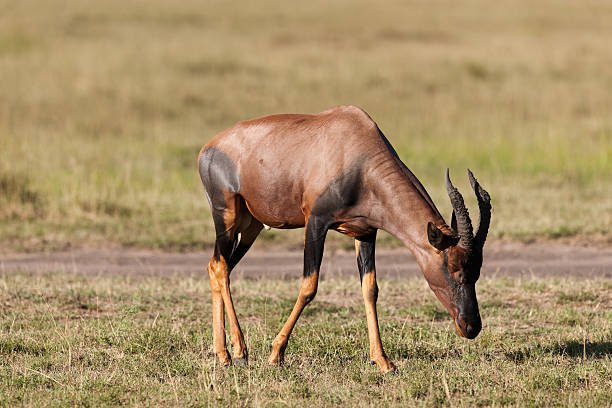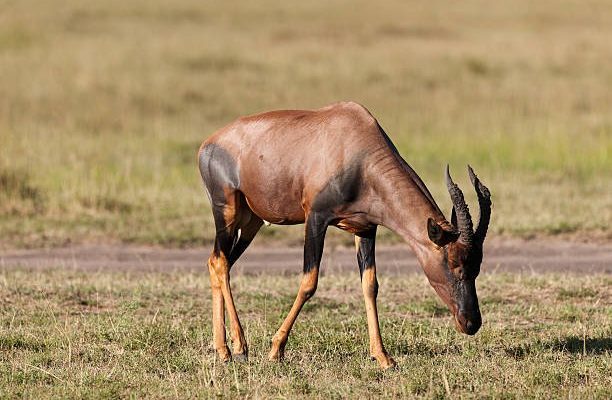
Let’s dive into the world of the topi to uncover its conservation status and the challenges it faces. Just like any other animal, the topi has its own story, and understanding it is crucial for its survival. Think of it as piecing together a puzzle—each piece helps us see the bigger picture of wildlife conservation.
What Exactly is a Topi?
The topi, or *Damaliscus lunatus*, is a medium-sized antelope native to the grasslands and savannas of East and Southern Africa. These animals are known for their long legs, which make them incredibly agile. But it’s their striking appearance that really catches the eye. With a deep chestnut body, darker face, and distinctive black markings on their legs and face, topis are quite the sight in the wild.
These social creatures often form large herds, which can number in the hundreds. You might see them grazing alongside other herbivores like zebras and wildebeests. Why do they do this? It’s a clever survival strategy! By mixing with other species, they can spot predators more easily. Honestly, it’s a bit like having a buddy system in school—safety in numbers!
Are Topis Endangered?
So, is the topi endangered? Currently, the International Union for Conservation of Nature (IUCN) classifies the topi as near threatened. This means they’re not at critical risk of extinction but face challenges that could push them closer to it. Factors like habitat loss, poaching, and increased human-wildlife conflict are major culprits.
In some regions, topi populations are declining due to the conversion of grasslands into agricultural land. When their natural habitat shrinks, topis have fewer places to graze, which can lead to starvation and decreased reproduction rates. Here’s the thing: when we take away their home, we’re not just affecting them; we’re impacting the entire ecosystem.
Habitat Loss and Its Impact
The topi thrives in open plains and grasslands, but these areas are increasingly being transformed into farmland. As more people move into rural areas, they clear land for crops and livestock, cutting into prime topi territory. This habitat loss not only decreases the amount of food available but also fragments populations, making it harder for them to mate and find genetic diversity.
Here’s a quick breakdown of how habitat loss affects topis:
- Reduced Grazing Areas: Less space means fewer food sources.
- Increased Competition: Topis may have to compete with livestock for the same resources.
- Isolation of Populations: Fragmented habitats can prevent groups from interacting, leading to inbreeding.
It’s a tough situation, and it’s not just about saving the topis; it’s about preserving a whole ecosystem that supports countless other species.
The Role of Poaching
Poaching is a significant threat to topi populations. In some regions, topis are hunted for their meat and hides, which can be lucrative in local markets. The demand for wildlife products continues to fuel illegal hunting, making it a pressing issue for conservationists.
Interestingly, while topis are not the main target like elephants or rhinos, they still pay a price. When poaching occurs, it disrupts social structures within herds, which can lead to decreased survival rates for young topis that need their mothers for guidance and protection.
Here’s the thing: it’s not just about the animals being hunted—poaching affects the entire community of species living in that area. We’re all interlinked. If one part of the ecosystem suffers, it can create a domino effect that impacts everything from plants to predators.
Conservation Efforts for Topis
Despite the challenges, there are ongoing conservation efforts aimed at protecting topis and their habitats. Organizations are working hard to establish reserves where topis can roam freely without the threat of poaching or habitat destruction. Community-based conservation projects are also on the rise, which includes involving local populations in protecting wildlife.
These efforts can be quite effective. For instance, when local communities have a stake in protecting topis, they’re more likely to help prevent poaching and habitat loss. Education and awareness are crucial here. When people understand the value of wildlife, they often become passionate advocates for its preservation.
Additionally, ecotourism plays a significant role in conservation. By attracting tourists who come to see these beautiful creatures in their natural habitat, communities can generate income while fostering a sense of responsibility to protect their wildlife.
What Can You Do to Help?
You might be wondering how you can contribute to conserving topis and similar wildlife. Here are a few practical steps:
- Support Conservation Organizations: Donations can help fund critical conservation projects.
- Educate Others: Share what you learn about topis and the importance of biodiversity.
- Practice Responsible Tourism: When traveling, choose eco-friendly tours that support local conservation efforts.
Every little bit counts! By spreading the word and supporting conservation initiatives, you’re helping to protect not just topis but a whole ecosystem that relies on their presence.
As we’ve discovered, the topi is facing some serious challenges, but it’s not too late. With ongoing conservation efforts and a commitment from local communities, there’s hope for these remarkable animals. By understanding the threats they face and taking action, we can help ensure that future generations will have the chance to see topis grazing peacefully on the savanna.
So next time you think of the African plains, remember the topi and all the hard work being done to protect it. Our planet is filled with incredible stories, and protecting each one is crucial for maintaining the balance of nature. Whether it’s through supporting conservation groups or simply spreading awareness, every action contributes to the greater good.

